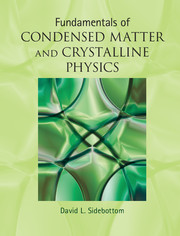 Fundamentals of Condensed Matter and Crystalline Physics
Fundamentals of Condensed Matter and Crystalline Physics Published online by Cambridge University Press: 05 August 2012
SCATTERING
Most of the light that enters our eyes has been scattered and when we see objects we see them because of the diffuse scattering of light they produce. Even the sky is blue because of how it scatters sunlight. But scattering is also an important mechanism for observing very small objects. As a classic example, recall how Lord Rutherford unveiled the internal structure of the atom by studying the scattering pattern of alpha particles directed at gold atoms. The abnormally large number of particles backscattered by these gold atoms pointed to the existence of a small, but very dense, center which we now refer to as the nucleus.
In the next chapter, we develop the basic framework for the scattering of waves by condensed matter by looking at how electromagnetic waves scatter from the electrons contained in the particles. Although this is strictly relevant only for the scattering of X-rays and visible light, much of the formalism that develops will apply equally to other waves, including particle waves (electrons or neutrons) that interact with things other than electrons. In the following chapter (Chapter 6), we look at how X-rays scatter from crystals. There we will find scattering that is reminiscent of how visible light is scattered by a diffraction grating in that the scattered radiation exits as a set of discrete beams. This discrete (Bragg) diffraction is contrasted in Chapter 7 by the continuous pattern of scattering produced by glasses or liquids.
To save this book to your Kindle, first ensure [email protected] is added to your Approved Personal Document E-mail List under your Personal Document Settings on the Manage Your Content and Devices page of your Amazon account. Then enter the ‘name’ part of your Kindle email address below. Find out more about saving to your Kindle.
Note you can select to save to either the @free.kindle.com or @kindle.com variations. ‘@free.kindle.com’ emails are free but can only be saved to your device when it is connected to wi-fi. ‘@kindle.com’ emails can be delivered even when you are not connected to wi-fi, but note that service fees apply.
Find out more about the Kindle Personal Document Service.
To save content items to your account, please confirm that you agree to abide by our usage policies. If this is the first time you use this feature, you will be asked to authorise Cambridge Core to connect with your account. Find out more about saving content to Dropbox.
To save content items to your account, please confirm that you agree to abide by our usage policies. If this is the first time you use this feature, you will be asked to authorise Cambridge Core to connect with your account. Find out more about saving content to Google Drive.